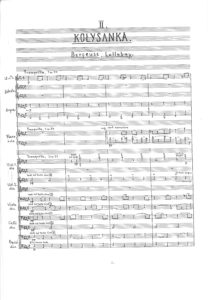Maciejewski was fond of lullabies, perhaps because his Lullaby for piano dedicated to his mother was one of his first, youthful compositions. While staying at Dartington Hall he wrote another lullaby, for two pianos (1938) and later arranged it for chamber ensemble and orchestra.
Maciejewski’s Lullaby for piano and orchestra is an example of a transfer of the convention of nineteenth-century piano literature to orchestral music. Maciejewski displays here great craftsmanship, loosing nothing of the intimacy marking solo performances. On the contrary, the expanded instrumental line-up does not destroy the nocturn-like nature of the piece, while the extraordinary melodiousness of themes, ostinatos in the orchestra or pendular movement in motifs (use of thirds and seconds) leave us in no doubt as to the author’s intention. In addition, gone is the traditional rivalry between the soloist and the orchestra (see e.g. themes highlighted in the wind instruments); both entities complement each other, which also fits with the “calming” convention carried by the programmatic title of the work. The celesta and harp parts bring to mind impressionism – focus on colour is one of the distinctive features of Maciejewski’s oeuvre, as is his “romanticising” emotionality. So how should his Lullaby be described in one sentence? It is a simple melody which will stay in the listeners’ minds like a mantra, hypnotising them.
The premiere of the orchestral version of Lullaby took place on 20 December 1975 in Redondo Beach. The piece was added to the 1944 Allegro concertante and since that moment both compositions have functioned as a diptych for piano and orchestra (although they can obviously be performed independently).
- R. Maciejewski, Lullaby, manuscript, p. 1 (PWM Edition)
- R. Maciejewski, Lullaby, manuscript, p. 2 (PWM Edition)
- R. Maciejewski, Lullaby, manuscript, p. 3 (PWM Edition)


